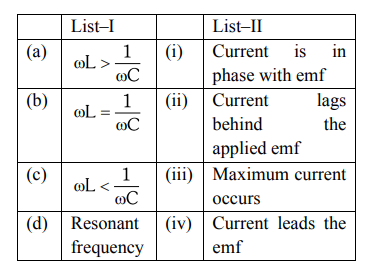Question:
Match List-I with List-II :

Choose the correct answer from the options given below:
Correct Option: 1
Solution:
(a) For $\mathrm{x}_{\mathrm{L}}>\mathrm{x}_{\mathrm{C}}$, voltage leads the current
(ii)
(b) For $\mathrm{x}_{\mathrm{L}}=\mathrm{x}_{\mathrm{C}}$, voltage \& current are in same phase
(i)
(c) For $x_{L} (iv) (d) For resonant frequency $\mathrm{x}_{\mathrm{L}}=\mathrm{x}_{\mathrm{C}}$, current is maximum (iii)
Click here to get exam-ready with eSaral
For making your preparation journey smoother of JEE, NEET and Class 8 to 10, grab our app now.
